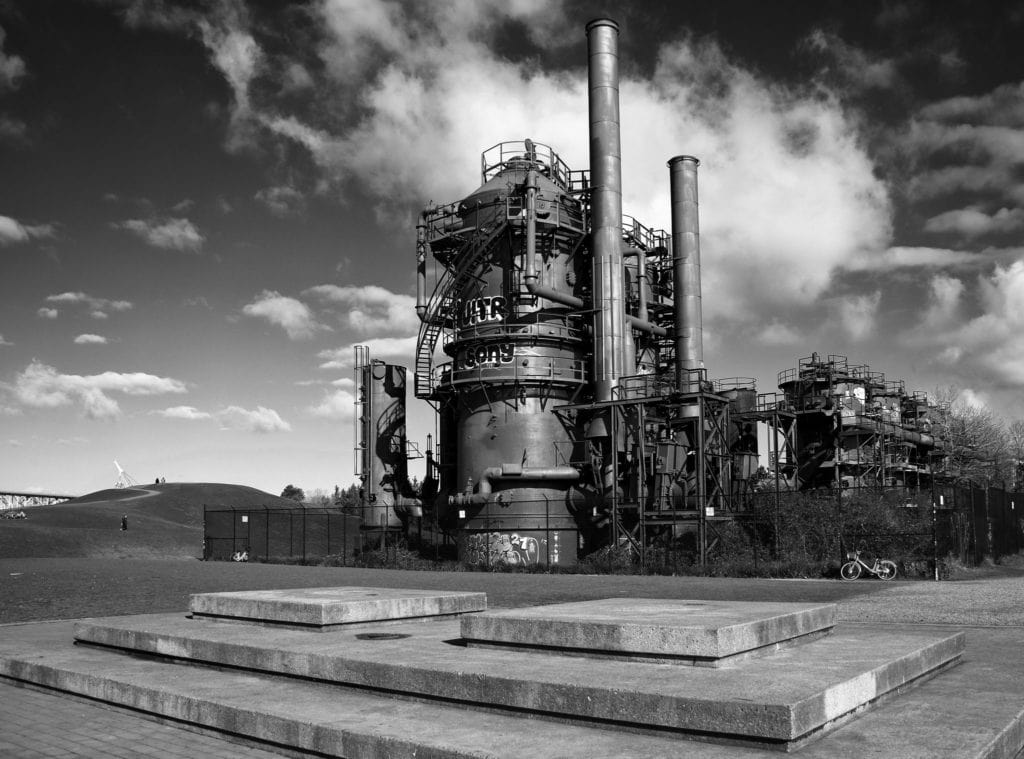 On the north shore of Lake Union, overlooking the skyline of downtown Seattle, a rusting collection of industrial era technology, partly overgrown and daubed with graffiti, forms the unlikely centre piece for Gas Works Park. I found myself there on a stop on an epic road trip from Vancouver to Tijuana with a small group of friends.
On the north shore of Lake Union, overlooking the skyline of downtown Seattle, a rusting collection of industrial era technology, partly overgrown and daubed with graffiti, forms the unlikely centre piece for Gas Works Park. I found myself there on a stop on an epic road trip from Vancouver to Tijuana with a small group of friends.
We were much taken by the Industrial Age monument, with its giant tanks, labrythine pipework and tall smokestacks, which now sits in green parkland. From a distance it looked to me like Howl’s Moving Castle. Closer, and out of its original context it has the air of a giant art installation. It is incredibly photogenic. I shot the accompanying picture with my Nikon Df using a circular polarising filter. The sun was just at the right angle to bring out a lot of contrast, and the clouds help give it a steam punk vibe.
Concrete train trestles greeted us at the park entrance. Part of the original 1906 gas plant, they apparently mark where the train tracks ended and coal was delivered, though as we had no idea what function they served at the time, they appeared completely abstract to us.
Reading up on the park after our visit, I was surprised to learn that during its productive life this was one of 1,400 coal gasification plants in the USA, converting superheated coal and crude oil into synthetic gas. Like a static Dr Who, it is now the sole survivor of its kind. It is also one of the earliest post-industrial sites to be transformed for public use through reclamation. Gas production ceased back in 1956 and the 19-acre site was acquired by the City in 1965, opening to the public 10 years later.
The story of its Gas Works Park usage starts with the arrival in Seattle of visionary landscape architect Richard Haag in 1958. An unsuccessful but well regarded finalist for another landscape project, he was subsequently awarded Gas Works. The idea of industrial buildings being preserved in parkland was unheard of in the 1950s. Unsurprisingly, there was considerable public debate about the site and its usage, but park supporters carried the day.
In addition to the Gas Works, the park features an artificial kite-flying hill created from on-site spoil. On the summit there is giant sundial constructed from glass, ceramics, and stone, where you can put your shadow to good use in telling the time.
As I mentioned earlier, my visit to Gas Works Park was on a stop on a West Coast road trip. Seattle’s weather was, as it is all too often, extremely wet. As the trip was at the beginning of April we were also subject to hail. Our one respite from bad weather there was the morning we visited the park – it was bright and sunny, though bitterly cold. We concluded that our trip to the park had been the highlight of our brief stop in Seattle. It is well worth a visit.